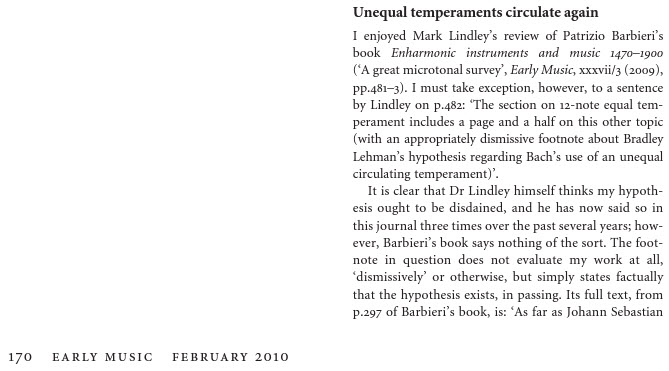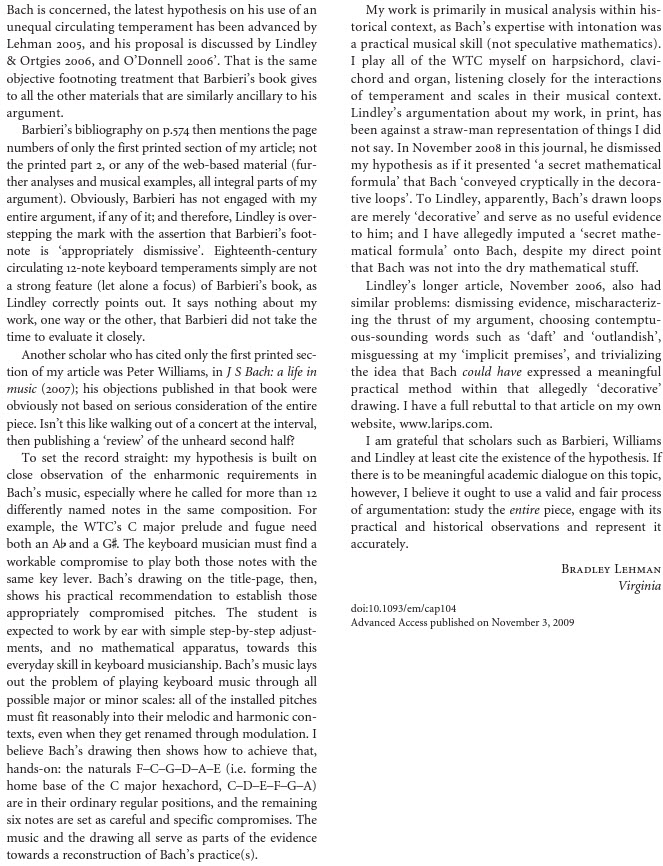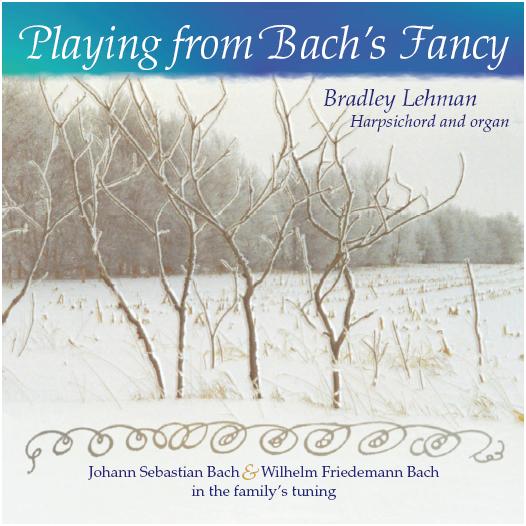 LaripS.com, © Bradley Lehman, 2005-22, all rights reserved. All musical/historical analysis here on the LaripS.com web site is the personal opinion of the author, as a researcher of historical temperaments and a performer of Bach's music.
Frequently Asked Questions, part 1OK, what's this all about? Please start with the informal talk if you haven't already seen it. I am taking Richard Feynman up on his quip that if one can't explain something in a basic level lecture, it's probably not worth knowing. That essay is my attempt at it. Another good place to start is my spring 2006 paper "Bach's Art of Temperament". That one explains some of the higher-level issues about keyboard temperament, from a musical standpoint. In 2021-22, I wrote "The Notes Tell Us How to Tune" to present everything as direct musical practice (i.e., with as little math as possible). What's the 2005 Oxford article about? Here is an outline of all its assembled parts: some in print, some on Oxford's web site (as "Supplementary Data" files, as "Case Studies" into Bach's compositions, and as six MP3 listening examples on harpsichord and organ). All of these are available for free download. It can't be summarized into merely a few sentences here; I urge interested readers to go to the outline page, download all the portions, and settle in for several hours of study! What's the simplest way to understand this temperament?
This process of minimal but necessary compromises makes the keyboard ready to play music in all 24 major and minor scales. Every scale has a subtly different expressive character, as the steps are not all exactly the same size. The harmonies have various tensions and spice, when the notes of the scales are built together into chords. Where can I hear samples of music tuned this way? The page of online samples is here. Several published recordings are already in circulation, and more are on the way. Two are by me [LaripS 1002] [LaripS 1003], and many other fine musicians have adopted this for their own use in concerts and recordings. The best way to get to know it is the most obvious practical one: set it up on harpsichords, pianos, and other keyboards and play with it directly! Complete instructions are here and in the Early Music article. This tuning is also installed on the new organ Opus 41 at Goshen College Music Center (Goshen, Indiana USA) as of January 2005, for regular use in academic and community events. [Specification and photos] [Recording] An existing Fritz Noack organ near Boston was converted to this tuning in March 2005, and a new organ in Helsinki Finland (by Christian Kögler) was dedicated in September 2005. [Specification and photos] Taylor & Boody have completed another organ in January 2006 for a church in Virginia. [Specification and photos] Is this for all sorts of keyboards, or is it only a specialty thing? All sorts, and all of the classic repertoire (especially 17th to 19th century music), plus any new improvisations and compositions. It is an all-purpose tuning that reveals exceptionally colorful and intense effects within tonal music. As of January 2006, I have personally heard music played in this tuning on 18 different harpsichords, two pipe organs, a fortepiano, a clavichord, two modern pianos, and an electronically sampled organ. These installations are variously at four or five different pitches, as to a starting frequency for "A" or "C"; the method is not limited to any particular set of Hz or string measurements. Synthesizer tuning files and formulas are available as well. My own interest is mostly in the classic acoustic instruments: harpsichord, organ, clavichord, fortepiano, Lautenwerk, and piano. Why use unequal tunings at all? More variety, more beauty, more compositional resources. This particular unequal tuning aids all tonal music, and especially that of the Bach family, to sound as lucid and beautiful as possible. The scales and harmonies all have a pleasing variety, contributing dramatic tension and resolution to the overall sound of the music. Historical accuracy is another plus, in understanding the original performing conditions expected by these composers. Equal temperament, by contrast, is bland--rather like looking at a black-and-white print from a color painting. Part of the emotional content has been removed. Is this "well-tempered" like in "The Well-Tempered Clavier"? Yes, that's exactly what this is: this specific layout as I believe Bach presented explicitly in that book. Everything sounds in tune all the time, through all major and minor scales and all the harmonies based on them. This tuning also solves all the outstanding problems of intonation in orchestral and vocal ensemble performance, as to transposing situations and the Affekt of the music. If this works well in Bach's music, what about other music that has nothing to do with Bach? For me this is as much an "all-purpose" solution for music, as I believe it was for Bach and his pupils/children. I have confirmed its utility with harpsichord, organ, clavichord, and piano. Everything works. What's "ordinary" and "extraordinary" temperament? These have their own page to answer that question. Does this method sound better than equal temperament, and better than the most refined Neidhardt and Sorge temperaments of 18th century Germany? Yes. Its balance of smoothness and interesting variety is unprecedented in historical documentation. This can hardly be explained adequately in words and charts, but my Early Music article is the attempt to do so. [Outline/download the article] Can ordinary non-technical listeners to music hear the difference here? Yes. By comparison, other harpsichord tunings sound jangly and rough in some music, especially Bach's music with complex harmonies. Those tunings make the whole instrument sound "tinny". Likewise, Bach's organ music runs into sounds that are harsh or sour in other organ tunings. But this tuning, almost like magic, simply sounds very easy to listen to all the time, unproblematic. The tuning does not draw attention to itself, but rather to the progress of the music. Its "unremarkableness", in that regard, is remarkable! Why was Bach's method ever lost? This is addressed in the first half of the Early Music article, February 2005. Recordings are available in autumn 2005, and samples too. How can I set this up with an electronic device, or by ear? There are two sets of electronic-tuner instructions [Main version] [Vocal-music version]. I don't use them myself, as I am a curmudgeon in favor of tuning by ear! The by-ear instructions are easy with a bit of listening experience: [Beginning] [Intermediate] [Expert]. Bach himself could tune the entire harpsichord in less than 15 minutes, by ear; and that's readily achievable again today, with practice. I do it all the time. It's a useful musical and practical skill: to know immediately when a certain note needs to be corrected, and in which direction...and to know with confidence that a given temperament has been established accurately.
My curmudgeonly soapbox: As Bach said about playing his compositions, when people accused them of being too difficult: "Only practice it diligently, it will go very well; you have five just as healthy fingers on each hand as I." (Forkel's biography) I would paraphrase that to apply to tuning-by-ear, also: practice it diligently, and it will go very well; use your two healthy ears and learn what to listen for. The more quickly one can get past reliance on any electronic measurement, the more the practical and theoretical principles are learned, and understood well. As of autumn 2007, a set of video demonstrations is available along with the several sets of by-ear instructions. I would also advise the diligent student to learn how to do regular 1/6 comma first, with confidence and speed. It is a basis for some other 18th century temperaments, as well. Knowing how to set 1/6 comma, it is especially easy to see and hear the Bach layout as a simple stretching of several intervals from that layout. B and the sharps are set a bit higher (using pure 5ths instead of the regularly tempered 5ths), and the flats are a bit lower than their regular 1/6 comma positions. The Bach layout is simply a "modified meantone", modified from 1/6 in some easy and tasteful ways. What does the entire 1722 title page look like? 
What are "commas" in tuning? There is far too much to go into here for that technical point; see the first half of my Early Music article for the basic background, and of course also the standard tuning literature. Briefly, the various commas are mathematical constants: errors that must be reconciled somehow in any keyboard tuning system. The goal is to allow pure octaves and reasonably good fifths and major thirds to be available simultaneously on a keyboard, such that an appropriate selection of music (which might be "all music") is performable. Some of the intervals must be made deliberately out of tune, by controlled amounts, to deal with these "commas". And the "schisma" is the geometric difference between the two main commas; that too must be reconciled somewhere within any keyboard temperament. See also my older web page about general issues of tuning. What about the various arguments that "1/6 and 1/12 comma stuff is too difficult and theoretical" or "the 55-division stuff is irrelevant for keyboards" or "the tuning should really be by beats per second instead of comma fragments"? Or dismissing Bach's diagram as in any way "complicated" that an 18th century teenaged student couldn't pick up, with or without any at-the-keyboard demonstration? All these arguments that I've seen so far are not against my thesis at all! Rather, they arise as people argue against their own misunderstandings of this practical tuning process. Let's try a short explanation, which might clear this up. This is a practical keyboard tuning that is trivially easy to set up on harpsichords, with a little bit of practice, in under ten minutes. It has nothing to do directly with commas or beats or 55-division or any of that technical material! Set those aside, temporarily, in the attempt to understand the tuning process. Those manners of mathematical/theoretical reckoning are only an attempt to explain or assign a more scientific measurement to the results, and to describe why and how it works, explaining them in a pedagogical way that 18th century experts of intonation would have understood. There is nothing cryptic here. In practice to set up this temperament on a harpsichord, one does not need to know anything whatsoever about commas, or even about beats. In relationship from some arbitrary reference pitch somewhere in the line, simply read across the diagram outward in both directions to build all the 5ths/4ths in turn. Try to think like a 10-year-old, being shown how to do a practical task (like tying shoes or making an omelet), with no mathematics whatsoever. Don't over-think it! Just do this, sitting at the instrument: if the loop on Bach's diagram has no jots in it, make a pure 5th/4th. If it has one jot, make it a very slightly impure 5th/4th, scarcely enough to notice. If it has two jots, make it more noticeably impure (but still scarcely enough to hear from more than a meter or two away from the harpsichord). To make these impure 5ths/4ths, just tweak the tuning lever the slightest bits until the interval develops some dirt: with little bits of rotation on the tuning pin. The amount of tempering in all these steps is to be sensed through practice and hands-on instruction, through experience doing the procedure a few times. Everything else after that is merely measuring the results, for the delectation of a more scientifically-oriented society in the 20th-21st centuries! My description as 1/6ths and 1/12ths of a comma (for the several different qualities of 5ths/4ths to be sensed as quality) merely makes it easy for other people to reproduce accurately enough, on the way to understanding the process and not merely hearing results. Those divisions as 1/6th and 1/12th comma simply round off the practical tuning with the same common measurements that were in Bach's milieu, and especially in the writings of Neidhardt and Sorge. For a sense of the appropriate precision and flexibility in all this, offering more leeway for taste or error than Neidhardt/Sorge did with their more scientific/theoretical approaches, look at CPE Bach's wording about keyboard tuning, passing along the practical thinking to the next generation of players. "Take away from most of the 5ths a barely noticeable amount of their absolute purity. All twenty-four tonalities will thus become usable...." [Basic and Intermediate instructions....] I've seen some arguments that one can't use 1/6 or 1/5 comma at all, unless authenticated sources can be located before Bach to "prove" that such tempering was really in vogue. To me, this hair-splitting is rather silly and immaterial. (As if nobody was allowed to have tuned that way, unless some expert happened to write it down for publication?!) My thesis is not about hitting those precise marks exactly, at its core. Rather, it is about making the major thirds "a little sharp" by "about that much" (the amount to be determined by taste and experience), where there are essentially two different sizes of narrowed 5ths...both being slight. It works out to be in the 1/6 comma region...if we must measure it. Practical tempering, such that it works out, getting the natural 5ths going with the appropriate spread. If we'd make the major 3rds of F-A and C-E to be too nearly pure, like in the 1/5 comma region (tighter tempered 5ths F-C-G-D-A-E), there is not enough left over for the three single-jot 5ths. All the available tempering room has been used up, within F-C-G-D-A-E. But it's common knowledge that "Bach invented equal temperament" or at least that he used it...isn't that so? No, the present research overturns that! Here, for example, is a passage from the 1984 edition of Baker's Biographical Dictionary of Musicians and it's still in the 2001 edition: Bach, Johann Sebastian, supreme arbiter and lawgiver of music, a master comparable in greatness of stature with Aristotle in philosophy and Leonardo da Vinci in art (...). Bach's system of "equal temperament" (which is the meaning of "well-tempered" in the title Well-Tempered Clavier) postulated the division of the octave into 12 equal semitones, making it possible to transpose and to effect a modulation into any key, a process unworkable in the chaotic tuning of keyboard instruments before Bach's time.The present research (both parts of the Early Music article, taken together) shows that none of Bach's music requires equal temperament, because he had a specific alternative of equal flexibility and superior musical felicity. He wrote it down. It solves all the problems of that "chaotic tuning of keyboard instruments before Bach's time", including all the pieces for which equal temperament was previously thought to be required. That is, the over-simplification is no longer necessary in historiography/hagiography and music theory, to force a conclusion of equal temperament upon Bach and his music (with the great hero paving the way for the modern age by adopting modern standard methods ahead of his time...yadda yadda yadda)! No, I don't have proof that Bach never deliberately used equal temperament; surely he knew about it from other people's harpsichords and organs. It's virtually impossible to prove a negative statement, anyway, such as an assertion that "he never used it." But, I have proof that he had something better than equal temperament, and therefore no compelling reason to switch away from it in favor of equal temperament. The asserted hypothesis I attempt to prove is: "Bach never required equal temperament"...because he had this other specific method that suited his work. But what about other people's arguments that Bach did use or expect equal temperament? Everything I have seen so far, in that regard, is merely a circumstantial or convoluted construction. And, most argumentation for equal temperament strikes me as a cop-out (borrowing a term from the 1970s) against taking unequal temperaments seriously in general, for their musical merits and their historical pedigrees. My survey of the past equal-temperament argumentation is in the Oxford article, and an additional section of commentary is here. More recently I have not seen any line of historically-oriented "proof" for equal temperament in Bach, offered by anyone who has thoroughly tried the proposed alternative as a direct comparison in Bach's music. (If anyone has a really convincing new one, please notify me!) The lingering arguments presented for equal temperament do not show awareness of this proposed sound, but merely rehash obsolete reference books as authority, or rehash general assumptions about Bach's process of practical transpositions. Unequal temperaments as a whole are dismissed without a further hearing: because typical unequal temperaments in past acquaintance have given some people a (rightful) bias against them. Typical unequal temperaments (such as Werckmeister 3, Vallotti, Kellner, Barnes) do have the problems pointed out by equal-temperament promoters. There is the roughness of flat-side music, the poor major 3rds in extreme keys, and so on. I have even lost a scheduled playing engagement once: in a situation where the conductor absolutely insisted to have equal temperament, and refused to give the Bach temperament a hearing first! The usual arguments against unequal temperaments were offered as "proof" that they would not take the time to try this alternative. So, we mutually decided that they should hire someone else who can tune/play equal temperament in good conscience. Did Bach need something suave and nearly-equal for the complex requirements of concerted vocal-music accompaniment? And something that does well with the orchestra playing in B-flat major with the organ in A-flat major? Yes, of course...but that doesn't prove he needed equal temperaments; only that some other unequal alternatives do not work well. Were Mattheson, Neidhardt, Bümler, Marpurg, Sorge, and other polemicists/theorists using equal temperament from any time c1705 forward, and into the 1720s and 1730s? Yes, of course they were (and Bümler and Sorge both became Bach's colleagues in the Mizler society in the 1740s)...but why assume that Bach would have agreed with them, or cared for any of the mathematical theory behind it? Equal temperament is musically less interesting and less resonant than a specific "equal-ish" alternative done by taste and experience, and equal temperament is more difficult to set up accurately without mathematical calculations! Bach was not a bandwagon-follower of trends around him; he tended to do things his own way, and to bring his personal intensity and critical thoughtfulness to his creative projects. And why would Bach draw a definitely irregular shape on the cover page of his own treatise/textbook about keyboard tuning, along with compositions that exemplify all the different moods of music available in the various keys? Surely Johann Sebastian Bach knew about equal temperament from his teens and early 20s, at the latest, through discussions with his own wider family of expert-musician Bachs. His own cousin Nikolaus had defeated Neidhardt in a tuning contest in 1706; see part 1 of my article for details. My thesis is that JS Bach knew very well about equal temperament (in the 1720s and earlier), and rejected its rise in practice by other experts, because he had something better-sounding already in hand. This was a major point in compiling the WTC as demonstration. His "equal-ish" temperament has the same complete flexibility through all keys, all equally usable, but with a healthy and interesting variety of characters also. It makes the jobs of the other players and singers easier and more natural, in the tensions and relaxations it reveals in the music. Interpretation becomes an instinctive reaction to the sound that is already happening: not a fight against equal temperament's sameness to put the phrasing across the footlights. What are all the "squiggle" discussions on the Internet and in print, and why do the issues seem so heated? Well, some of the discussion is "so heated" because (by 2008-9) some of it is little but an entrenched litany against this whole line of research. The same things come up, every few months, and the same several people regularly shout down any new questions. Then, others complain that it's all been discussed already. Declarations are made that there's nothing reliable here to know; see, for example, Thomas Dent's well-reasoned yet dismissive position paper about it [or another copy]. Some of the critics reduce the issue to dilettante graphology...because (apparently) that's the only level of investigation they can handle, toward their foregone conclusion of rubbishing it all. Here's an example, from February 2009. The proposal of "Bach" temperaments touches so many issues of practicality, theory, history, and epistemology, it's a loaded environment. An essay of response by me, in that regard, is on the HPSCHD-L discussion list 6 March 2006. There are also disagreements as to what types of evidence should even be admitted to discussion. My Oxford article brought up musical and historical points that some other scholars would throw off the table. Here is my response to a published article that does that, and a follow-up in January 2009, from some of the online quarrelling. To me, the important issues are the study of Bach's music, its historical context, its enharmonic requirements, the normality of 1/6 comma tempering, and then Bach's drawing within that context. If Bach intended to provide a diagram that indicates a straightforward sequence of adjustments, working at a harpsichord, what might he draw? If discussions can rise above puerile levels of personal abuse, and start to take all that evidence from Bach seriously, there might be much to learn through them. What about the fact that a handful of experts still don't agree with your interpretation or articles, and have published criticism that "debunks" all or parts of it? I take the expert criticism seriously, as it helps to refine parts of the theory; much of that already happened before publication of the first paper, and it continues. My interpretation fits the evidence, is easy to tune by ear, and sounds effective in the music. The disagreeing experts are trying to prove the negative case: that Bach's "couldn't have" (or "wouldn't have" or "didn't") do or intend the things that I have argued. Bach's music and drawing together somehow couldn't lead to the temperament I proposed? I closely examine the criticism itself, to see if it holds to the same critical standards it is putting forward (that's only fair, isn't it?). Some criteria:
Here is my 2009 letter to Early Music as printed in the February 2010 issue. I set out the hypothesis clearly, and I called for valid and fair engagement of the argument.
That 2009 letter also set the stage for setting out that hypothesis more clearly again in 2021-22, becoming the newer article "The Notes Tell Us How to Tune". I've seen this work dismissed as "totally speculative", or not scientific enough, or otherwise flawed along that line. It all falls to be one person's aesthetic tastes over another's, and nothing is proven. What's your reaction? It's weak rhetoric! Beyond questions of tuning, other "totally speculative" areas of historical performance practice research include appropriate fingering methods, tempo choices, basso continuo improvisation, and what types of shoes (if any) organists ought to wear. All we can do is to put together historical clues in the music, other writings, traditions, and practical experimentation with appropriate instruments. Beyond the reproducible measurement of surviving objects, are there many areas of 18th century historiography itself that are not wholly or mostly speculative? In the taste argument, the sword has to cut both ways. Some experts (and non-experts) don't fancy the sound, or take it to be part of the evidence, but many do. [Recordings] [Concerts] Some people assert that the sound is too smooth, while others argue that it's too spicy! For some, the sound itself is so convincing that all other argumentation becomes secondary; this temperament makes the instruments sound usefully better. If Bach and his expert colleagues had something that sounds this fine, might they not have used it, too? Where is additional Internet discussion of these various tuning principles? Most of my participation in that regard has been on the HPSCHD-L discussion list. I have assembled a (growing) digest of my postings there, with many details about the research, and responses to additional questions. There are rumors of someone named Sparschuh deriving a temperament from Bach's drawing as early as 1999. Where is the material about him and his hypothesis? I have described and credited Andreas Sparschuh's work, on these eleven web pages:
Sparschuh has also been credited by at least six writers in the journal Early Music (in three articles including mine, and an editorial, and in printed journal correspondence 2005-7); and in Clavichord International (2005, in both my own article there and the editorial introducing it). At least two books by others have also cited Sparschuh's idea:
My own opinion about all this is presented in the resources noted here. But, it's summarized well by John Marks in his Stereophile article February 2007, in his footnote: "Lehman acknowledges that previous investigators have suggested that the calligraphic doodle holds the key, but he claims with some justification that the previously proposed solutions are unworkable." Haven't there been quite a few "Bach" temperament proposals by other people, already? Yes, and it continues into at least 2009! See the survey of other "Bach" temperaments. What is the LaripS record label? We founded it in 2005 because, like John Eliot Gardiner, we believe it is more important to have complete artistic control over a produced classical recording than to pose in wet bikinis. Most of our releases will feature performances in Bach's tuning. All of them, so far, are produced by Bradley Lehman in collaboration with several engineers and graphic artists. When we get time to work on it, we will seek wider distribution with established distributors. Until then, the publications are available directly from the producer and several personal agents, as Bach did with his published books. The "LaripS" name is the word "Spiral" spelled backwards: since that is the encoding of Bach's tuning, spirals going from right to left (i.e. before the page is inverted). Releases: [1001] [1002] [1003]
Continue with more questions in part 2...  |
v Introduction v Articles > FAQ * page 1 - page 2 - page 3 - HPSCHD-L v Practice v Theory v History v Etc v Recordings |





